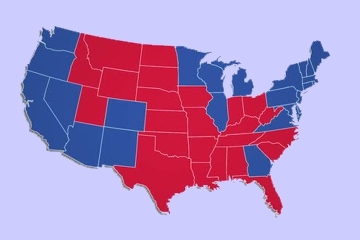|
The current political mess in the United States historically is nothing new. It is reminiscent of the political turmoil that that we have seen before in the lead up to the Civil War of 1861, and has its roots in the same problem of inevitable changes in the division of power between the states.
From before the founding of the independent nation following the colonies’ war with Britain that ended in 1783, conflicting interests in the country have taken it close on more than one occasion to dissolution. The Civil War of 1861 is the most violent example and was probably inevitable given the circumstances, and it could be said was not even the first civil war in the American society.
Historian Kevin Phillips makes a case that the English speaking world had three connected civil wars, the English Civil War of 1642, the American Revolution, and the American Civil War. Historian Alan Taylor includes the War of 1812 against Britain also as a civil war.
The established narrative has been that the country was founded in reaction to the “tyranny” of British rule in the thirteen colonies. That is a convenient piece of propaganda but nowhere near the complex reasons that lead to the revolt of the colonies from crown rule.
One could sum it up by spoiled brats in the New England colonies getting into a pissing match with an obstinate British Parliament which eventually lead the British to take firmer control of New England which in turn ramped up the resistance of some New Englanders who were in a state of revolt by 1774.
The middle and southern colonies joined with the New England colonies for their own reasons, opening of the lands west of the Appalachians to real estate speculation which the Crown had been forbidding, and protection of the slave economy in the south. When the British finally decided that the colonies were not worth the cost to continue the war and granted independence the result was thirteen colonies loosely joined in a dysfunctional confederation.
It was apparent to many of the leaders of the revolt that such a confederation could not survive and that a stronger national format was imperative if the colonies were to remain independent from European powers. To fix the problem a convention was called to write a new constitution that would create a strong central government. How strong was an issue of debate which resulted in compromises granting powers to the states. In order to get the southern states to join the new union provisions had to be made to protect slavery in the south and increase the power of the slave states in the union by allotting each slave to count as three fifths of a person when calculating each states entitlement to representation in The House of Representatives.
Much has been made about slavery in the US, but it is not the fact of slavery itself that was the most contentious, but the division of power that it represented. As the union grew in size and new territories in the west were acquired and new states were being created, the question arose as to whether those states would be free soil or slave. To maintain its political power and protect its social and economic system the slave states need to maintain parity with the free states so the creation of new states became a major item of contention. The free states on the other hand did not want more slave states, particularly given the rise of abolitionist sentiments in many of the northern states.
The history of the forty years leading up to the Civil War is a history of agreements between the free and slave states and of the slave states continually pushing the envelope and forcing new agreements more favorable to their cause. They were outnumbered and slavery was doomed, and actually had been since the founding of the republic when many of the slave holding “founding fathers” themselves decried the institution and projected it eventual demise. With the election of Lincoln in 1860 the south believed that there was no hope to maintain their position and seceded from the union.
We face much the same problem today, though instead of slavery the key issue of state power is voting rights. Now we can compare the blue states to the free states of 1860 and the red states to the slave states. The red states are threatened now because the majority of the country has turned blue, with many blue areas in the red states, and in order to maintain their position in the national government the red states need to find ways to suppress their blue voters. Conversely the blues need to find ways to defeat this suppression and get more people to the polls.
Like in 1860 the numbers are against the red states, and their power will eventually be reduced. The question remains how much strife must the country suffer through before this comes to pass.
For those who want to know more about the early history of the republic I found the following sources of interest:
DeRose, Charles. The Presidents’ War, Six American Presidents and the Civil War That Divided Them. Guilford, CT: Lyons Press, 2014
Freeman, Joanne B. The Field of Blood: Violence in Congress and the Road to Civil War. New York: Farrar, Straus and Giroux, 2018
Horne, Gerald. The Counter-Revolution of 1776, Slave Resistance and The Origins of The United States of America. New York: NYU Press, 2014
Phillips, Kevin. The Cousins’ Wars: Religion, Politics, and the Triumph of Anglo-America. New York: Basic Books, 1998
Rasmussen, Dennis C. Fears of a Setting Sun, The Disillusionment of America’s Founders. Princeton: Princeton University Press, 2021
Taylor, Alan. The Civil War of 1812: American Citizens, British Subjects, Irish Rebels, and Indian Allies. New York: Alfred A. Knopf, 2010,
|
